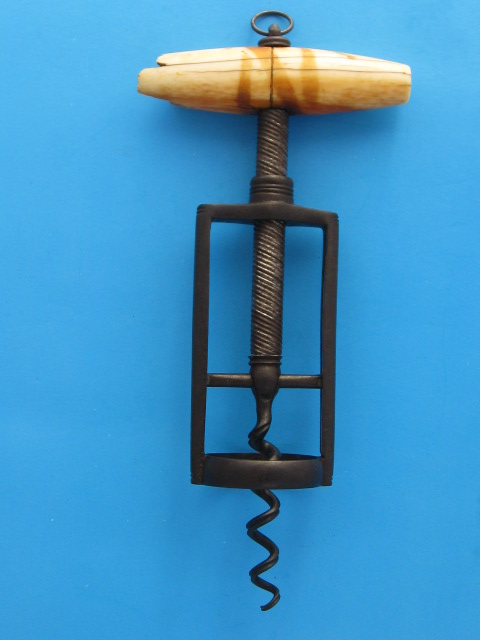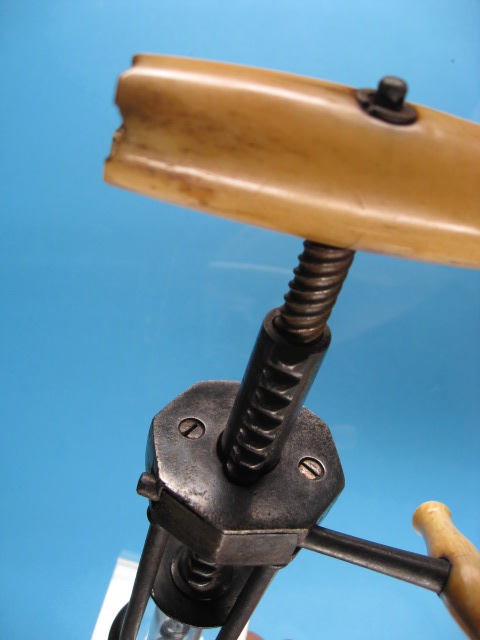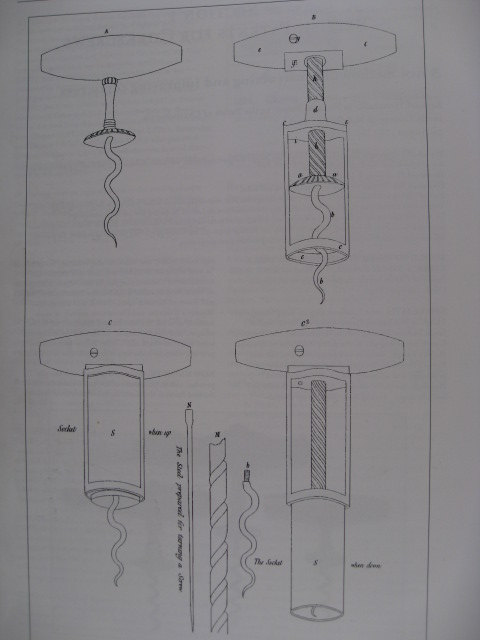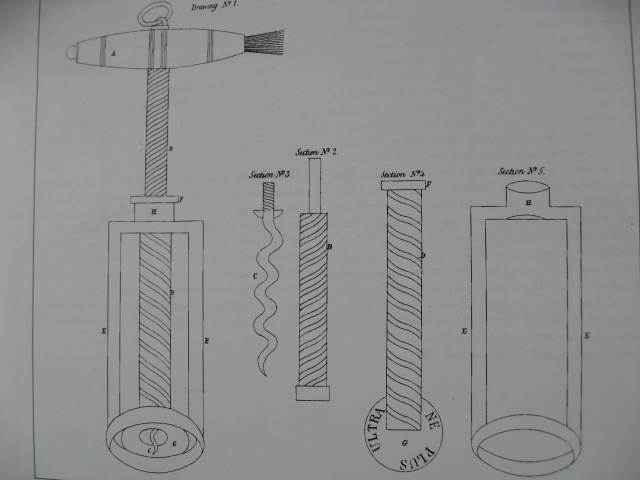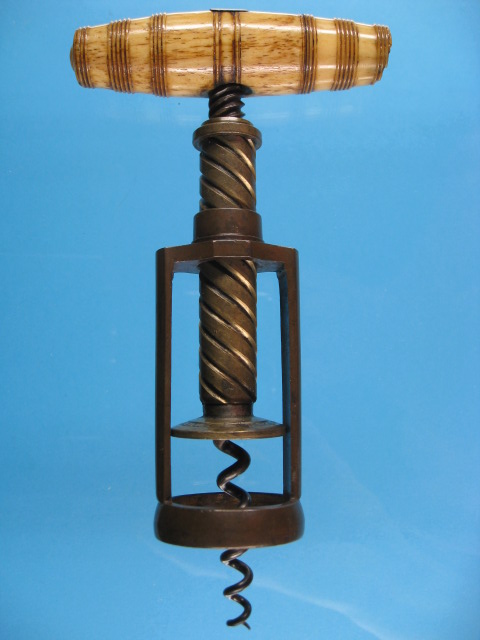Early Mechanical Corkscrews from the 18th and Early 19th Centuries.
THE EARLIEST MECHANICAL CORKSCREWS
The earliest mechanical corkscrews include the beautiful Tire-Bouchon a Cage examples, from France. Some of these examples date back to the 17th century. The French Cage corkscrews are generally cylindrical in form and are made from pierced steel. A few examples are known with balusterd or turned columns (pillars). There are cage corkscrews made from ivory with sheath guards, as well as silver and gold.
These early cage type corkscrews are fenstrated to enable easy removal of the extracted cork from the worm. The proportions and balance of these early pieces is very fine and the size surprisingly small.
 (640x426).jpg)
Delicate open barrel corkscrews made by craftsmen from England, Ireland and France are known dating from the mid 18th century.
Corkscrews manufactured by Irish makers, Singleton, Read and Lamprey, thought to date from the late 18th century are also known to exist. Examples are found in steel and brass. Once again these pieces have fenstrations to enable corks that have been withdrawn from bottles to be removed from the worm. These pieces have a fine balance and proportion. A brass open frame mechanical corkscrew manufactured by John Read, along with a silver open framed corkscrew from the 18th century have also been discovered.
Below an example of an 18th century II Pillar English steel mechanical corkscrew is shown. Notice the fine balance and proportion. These early makers were indeed artisans, later examples from the mid 18th and 19th century are heavier in construction and usually less desirable.
Notice the plain simple handle and the narrow bottle ring at the bottom of the corkscrew. The grooved worm is definitely original, showing these worms were in use very early on in the history of corkscrews.
Open framed corkscrews with threaded shafts were made in the late 18th century, they are not common. Pieces are known with both right hand and left hand threaded shafts. Handles on these early pieces were made from wood, ivory, often marine ivory and bone, as well as steel. Simple in design, handles were often plain but some did have very fine turnings.
Most threaded shaft II pillar corkscrews from the 18th century have a bar or plate to stabilise the worm when in use.
EARLY KINGS SCREW CORKSCREWS
The early Kings Screw corkscrew originated from the 18th century and was only made in the narrow rack form. These Kings Screws were close-plated or when plain steel, they were blued in oil and burnished to a bright finish. Both these processes helped prevent corrosion and protected the corkscrews.
Sir Edward Thomason revised close-plating in the early 19th century for small articles, Thomason was involved with Thomas Dowler a fellow close-plater and corkscrew maker.
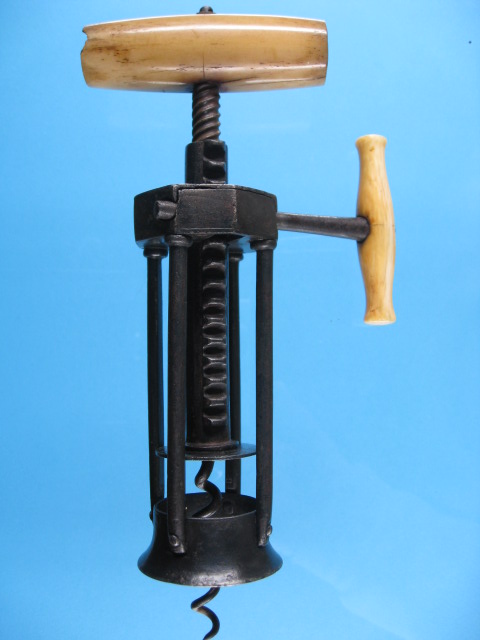
The Kings Screw shown above from a private collection is from the late 18th century. It has a flat top plate which covers the internal mechanism. This plate is secured by two screws, which can easily be removed to facilitate cleaning or repair of the pinion inside.
The rack on this early Kings Screw is hand cut from one piece of steel. An unusual feature with this pictured Kings Screw is that the side winding handle faces in the opposite direction to other examples, requiring anti-clockwise turning to raise the cork from the bottle neck. Possibly this corkscrew was commissioned by a left handed person, these early corkscrews were often one off pieces, made to order.
SAMUEL HENSHALLS PATENT
Samuel Henshall along side Matthew Boulton the famous entrepeneur and manufacturer of the 18th century produced the firsrt mechanical corkscrew that was granted Patent Protection.
Patent Protection usually ran for fourteen years, during which time the inventor, having been granted Patent Protection, was given monopoly rights, enabling him to produce his invention without competition. The procedure for obtaining Patent Protection was very lengthy and expensive.
Henshall was granted Patent Protection on the 24th August 1795, for his corkscrew design, No 2,061. Three forms of corkscrew were made by Henshall and Boulton under this patent.
Henshall I - Simple form made in two sizes for pint and quart size bottles.
Henshall II - Compound form.
Henshall III - Compound form with socket.
Above is a copy of one of the drawings that accompanied Henshalls Patent application. It clearly shows the two variations of Henshalls mechanical corkscrew manufactured from 1795 onwards. Very few examples of this English corkscrew are known to exist to date. Interestingly letters from Henshall on September 28th 1795 and January 12th 1796 contained references to corkscrew frames made from both iron and brass.
The Henshall "Compound" corkscrews were like earlier 18th century mechanical corkscrews in that they were of open-frame construction, this design again allowed easy removal of an extracted cork.
EDWARD THOMASON'S PATENT
Now we move on to Sir Edward Thomasons 1802 Patent corkscrews. Like Henshall Edward Thomason had a close relationship with Matthew Boulton. Edward Thomasons father sent Edward to Matthew Boulton at the age of sixteen where he learnt his trade.
The second patent application for a corkscrew in England was made by Sir Edward Thomason on May 7th 1802 No 2,617. This corkscrew design was to be one of the most successful ever. A design that was later copied by numerous other corkscrew manufacturers.
Thomasons corkscrew had both male and female threads as part of its mechanism. By placing Thomasons corkscrew over the bottle neck and continually turning the handle clockwise, the worm penetrates the cork and eventually withdraws it from the bottle. Next by turning the handle in the opposite direction the cork eventually falls from the worm without the user touching it and soiling his fingers.
Thomason himself described the action of his new invention as "three screws working together".
The line drawing that accompanied Thomasons patent application shows only an open two column frame corkscrew. No closed barrel examples are shown in the patent specification drawings.
Thomasons patent corkscrews were made with II, III, IV and VI pillars. Some examples are known in bronze and others are known in steel. Two examples are shown below.
.jpg)
.jpg)
These two Thomason types are both relativly early pieces, of narrow pillar or rod construction Both are steel examples rather than bronze or brass. The earlier Thomasons were generally made from steel, probably with the exception of a bronze II pillar example made almost exactly to the design shown in the patent specification drawings. An example of the bronze II pillar made according to these drawings is shown below.
.
What can we focus on when trying to establish which of Thomasons corkscrews were the very earliest examples? We can look carefully at the drawings that accompany the patent specification. Also we can study early trade catalogues. This is discussed in a seperate article entitled.....
WHICH OF EDWARD THOMASONS CORKSCREWS WERE MANUFACTURED FIRST??

